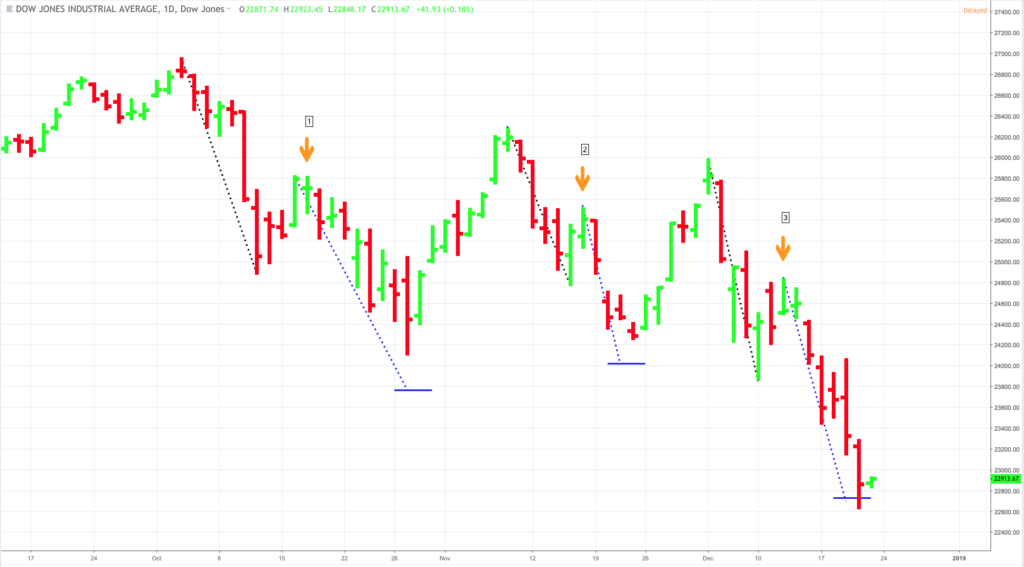Following up on our last article on using previous support levels as potential profit targets for short positions, let’s now talk about another method that uses not historical price levels but projected price swings.
Here’s the scenario: let’s suppose you are short a market that is reaching lows that have not been touched for a relatively long period of time. The Dow Jones chart below is NOT an example of this scenario, but we can still use it to demonstrate the main idea.
Introducing the Measured Move
A measured move is a 3-part price swing projection. It is based on the technical principle that in an uptrend, price swings upward (swing 1) , retraces (swing 2), and then continues to swing upward (swing 3). In a downtrend, price swings downward (swing 1), retraces (swing 2), and continues downward (swing 3).
The “theory” behind it is that the length of Swing 1 from bottom to top should be equal to, or nearly equal to, Swing 3 starting from the end of Swing 2.
Upward Measured Move Example:
So if Swing 1 goes from $5 (low) to $15 (high), and if Swing 2 retraces from $15 back down to $10, then Swing 3 is projected to move from $10 (low) to $20 (high).
The same applies to downward swings but in reverse.
How accurate are the projections?
Here is where some technical traders will disagree. Our position on this matter isn’t about predictive power or accuracy. We are using this as an objective means to measure a potential target.
Would you rather go short the market with no reference point, or would you rather have an objective target to help assess your trade? We’d like to believe that you’d prefer the latter instead of trading with no guidance or terminal point.
Let’s jump into a hypothetical trade to demonstrate how to use this technique.
Dow Jones September 14 to December 21, 2018 (below)

Trade 1:
- Swing 1 (black dotted line) moved 2052.04 points from a high of 26951.81 to a low of 24899.77.
- The end of the retracement, Swing 2, is at 25817.68.
- We subtract 2052.04 points from Swing 2’s high and come up with a measured move target of 23765.64.
You can see that the target hadn’t been reached but price came close.
Trade 2 gives us a similar scenario as trade 1.
- The length of the measured move is 1490.03 points.
- The high of the Swing 3 starts at 25510.23.
- The measured move target at 24020.20 wasn’t reached but price came close.
But trade 3 gave us a scenario in which the target at 22729.45 had been reached.
Main Point: the measured move approach can provide guidance in situations where no immediate price target is in sight.
Although we are applying this technique to a short trade, it might be particularly useful in uptrending situations where an asset is reaching new and unexplored highs (in which case there is no historical price resistance).
Please be aware that the content of this blog is based upon the opinions and research of GFF Brokers and its staff and should not be treated as trade recommendations. There is a substantial risk of loss in trading futures, options and forex. Past performance is not necessarily indicative of future results.
Disclaimer Regarding Hypothetical Performance Results: HYPOTHETICAL PERFORMANCE RESULTS HAVE MANY INHERENT LIMITATIONS, SOME OF WHICH ARE DESCRIBED BELOW. NO REPRESENTATION IS BEING MADE THAT ANY ACCOUNT WILL OR IS LIKELY TO ACHIEVE PROFITS OR LOSSES SIMILAR TO THOSE SHOWN. IN FACT, THERE ARE FREQUENTLY SHARP DIFFERENCES BETWEEN HYPOTHETICAL PERFORMANCE RESULTS AND THE ACTUAL RESULTS SUBSEQUENTLY ACHIEVED BY ANY PARTICULAR TRADING PROGRAM.
ONE OF THE LIMITATIONS OF HYPOTHETICAL PERFORMANCE RESULTS IS THAT THEY ARE GENERALLY PREPARED WITH THE BENEFIT OF HINDSIGHT. IN ADDITION, HYPOTHETICAL TRADING DOES NOT INVOLVE FINANCIAL RISK, AND NO HYPOTHETICAL TRADING RECORD CAN COMPLETELY ACCOUNT FOR THE IMPACT OF FINANCIAL RISK IN ACTUAL TRADING. FOR EXAMPLE, THE ABILITY TO WITHSTAND LOSSES OR TO ADHERE TO A PARTICULAR TRADING PROGRAM IN SPITE OF TRADING LOSSES ARE MATERIAL POINTS WHICH CAN ALSO ADVERSELY AFFECT ACTUAL TRADING RESULTS. THERE ARE NUMEROUS OTHER FACTORS RELATED TO THE MARKETS IN GENERAL OR TO THE IMPLEMENTATION OF ANY SPECIFIC TRADING PROGRAM WHICH CANNOT BE FULLY ACCOUNTED FOR IN THE PREPARATION OF HYPOTHETICAL PERFORMANCE RESULTS AND ALL OF WHICH CAN ADVERSELY AFFECT ACTUAL TRADING RESULTS.